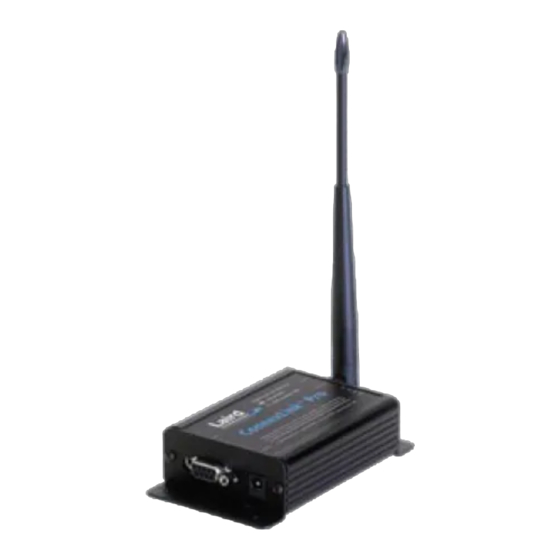
Laird CL4790 User Manual
Hide thumbs
Also See for CL4790:
- Hardware integration manual (13 pages) ,
- Quick start manual (14 pages)
Summary of Contents for Laird CL4790
- Page 1 CL4790 UIDE ERSION Americas: +1-800-492-2320 Option 2 Europe: +44-1628-858-940 Hong Kong: +852-2923-0610 www.lairdtech.com/ramp...
- Page 2 The preceding statement must be included as a CAUTION statement in manuals for OEM products to alert users on FCC RF Exposure compliance. Caution: Any change or modification not expressly approved by Laird could void the user’s authority to operate the equipment.
-
Page 3: Revision History
CL4790 User Guide Version 2.0 EVISION ISTORY Version Date Changes Initial Release Changes and Revisions 02 Aug 2013 Major changes and revisions; updated format and data Separated Hardware Integration Guide (HIG) from User Guide information 18 Dec 2013 (created two separate documents). -
Page 4: Table Of Contents
CL4790 User Guide Version 2.0 ONTENTS Revision History ............................3 Contents ..............................4 CL4790 RF Transceiver ..........................5 Overview ................................5 Features ................................5 Theory of Operation ..........................6 RF Architecture ..............................6 Network Topologies ............................. 6 Modes of Operation ............................. 6 Security ................................ -
Page 5: Cl4790 Rf Transceiver
CL4790 transceivers operate in a Masterless architecture. When a CL4790 has data to transmit, it will enter transmit mode and start transmitting a sync pulse intended for an individual radio or broadcast to all transceivers within the same network and range. -
Page 6: Theory Of Operation
The LINK LED on the CL4790 illuminates to show that it is In Session. A transceiver enters Transmit or Command mode when the OEM host sends data over the serial interface. The contents of the data on the serial interface determine which of two modes the radio enters. - Page 7 CL4790 User Guide Version 2.0 sending the packets until either (1) it receives an acknowledgement, or (2) it has used all transmit retries. The received packet only sends to the OEM host if and when it is received free of errors. Note: If Transmit Retries is set to 1 the radio will only attempt to send the data one time with no retries, the minimum setting for Transmit Retries is 1 and cannot be set to 0.
- Page 8 CL4790 User Guide Version 2.0 When an addressed packet or a response to a broadcast packet is sent, the sending radio will listen for a successful acknowledgement. If an acknowledgement is not sent, the radio will resend the packet until either an acknowledgement is received or it has exhausted all available transmit retries.
- Page 9 CL4790 User Guide Version 2.0 Figure 1: Pending RF data in buffer flow CONN-GUIDE_CL4790 Americas: +1-800-492-2320 Option 2 Europe: +44-1628-858-940 Hong Kong: +852-2923-0610 www.lairdtech.com/ramp...
- Page 10 CL4790 User Guide Version 2.0 Figure 2: Pending RF data in buffer flow CONN-GUIDE_CL4790 Americas: +1-800-492-2320 Option 2 Europe: +44-1628-858-940 Hong Kong: +852-2923-0610 www.lairdtech.com/ramp...
-
Page 11: Security
CL4790 Security Features In addition to FHSS technology, Laird has implemented three levels of security in the CL4790. All three levels associate with their own EEPROM parameter that you may program for permanent operation or change... -
Page 12: Programming The Cl4790
There are a total of 256 System ID values. In FHSS technology, RF Channel Number and System ID are still not enough to secure your data. The CL4790 supports the Data Encryption Standard (DES), which is the third level of security. Encryption is the process of encoding an information bit stream to secure the data content. - Page 13 Version 2.0 Note: All CL4790 units ship with a default baud rate of 57600 (unless units have been pre-configured to match specific serial settings). If the Interface Baud Rate of the CL4790 unit is changed, the PC Setting baud rate must match the device baud rate to allow proper programming of the units.
-
Page 14: Appendix I: Troubleshooting
Reference source not found.. If any other program using the same COM port as CL4790 is open, close that program and try to read the radio again. Reset the radio by cycling power after each unsuccessful read. Write Radio displays error: Cycle power to the radio. - Page 15 CL4790 User Guide Version 2.0 Select the appropriate port from the drop-down list. Set the rest of the settings to: Baud Rate: 9600 Parity: None Handshaking: Hardware Data Bits: 8 Stop Bits: 1 Read/Write with AT Commands Under Options, ensure the check box is selected.






Need help?
Do you have a question about the CL4790 and is the answer not in the manual?
Questions and answers